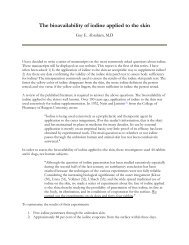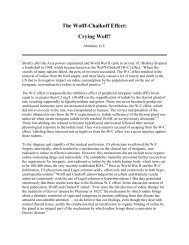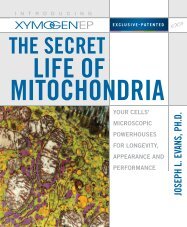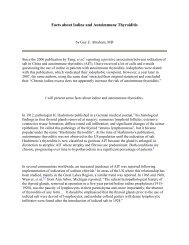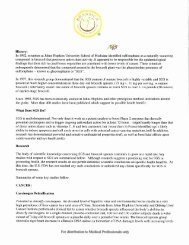Subcutaneous and visceral adipose tissue - Beck Natural Medicine ...
Subcutaneous and visceral adipose tissue - Beck Natural Medicine ...
Subcutaneous and visceral adipose tissue - Beck Natural Medicine ...
Create successful ePaper yourself
Turn your PDF publications into a flip-book with our unique Google optimized e-Paper software.
16 <strong>Subcutaneous</strong> <strong>and</strong> <strong>visceral</strong> <strong>adipose</strong> <strong>tissue</strong> M. M. Ibrahim obesity reviews<br />
Future directions<br />
Research is needed on the molecular <strong>and</strong> cellular mechanisms<br />
<strong>and</strong> signals for <strong>adipose</strong> <strong>tissue</strong>. Determination as to<br />
which adipocyte factors are most important in promoting<br />
metabolic disease will be an important focus for future<br />
studies.<br />
Manipulation of adipocyte biology might be a useful<br />
therapeutic strategy in metabolic disease. There is a lot of<br />
work that remains to be done in the area of adopocytes <strong>and</strong><br />
adipokines physiology. There are large gaps in our knowledge<br />
about the mechanism of action of many adipokines.<br />
The existence of additional, yet-unidentified adipocytespecific<br />
factors is highly likely. Prospective cohort trials that<br />
use imaging procedures to estimate abdominal <strong>and</strong> various<br />
<strong>adipose</strong> <strong>tissue</strong> depots in a precise manner, assess biochemical<br />
<strong>and</strong> metabolic parameters in relation to cardiovascular<br />
endpoints are needed.<br />
Racial differences in the accumulation of <strong>adipose</strong> <strong>tissue</strong><br />
depots <strong>and</strong> resulting cardiovascular risk need further<br />
investigation.<br />
Abdominal obesity is very common in Middle Eastern<br />
countries (74). Women in Egypt <strong>and</strong> Turkey have the highest<br />
proportion of overweight as well as the highest proportion<br />
of obesity (75). Ongoing studies are aiming to identify the<br />
WC cut-off points that define the threshold of abdominal<br />
obesity <strong>and</strong> an abdominal waist girth. There are racial <strong>and</strong><br />
genetic variations in body fat distribution that dictates the<br />
needs for different thresholds of abdominal obesity among<br />
different populations. We are currently correlating in a<br />
cross-sectional study (MM Ibrahim et al. unpublished<br />
observations) the prevalence of a number of cardiovascular<br />
risk factors at different levels of WC. The cut-off point based<br />
upon this approach is different from the threshold among<br />
US, European <strong>and</strong> Asian men <strong>and</strong> women.<br />
Conflict of Interest Statement<br />
No conflict of interest was declared.<br />
References<br />
1. Vague J. The degree of masculine differentiation of obesities: a<br />
factor determining predisposition to diabetes, atherosclerosis, gout<br />
<strong>and</strong> uri-calculus disease. Am J Clin Nutr 1956; 4: 20–29.<br />
2. Bruun JM, Lihn AS, Pedersen SB, Richelsen B. Monocyte<br />
chemoattractant Protein-1 release is higher in <strong>visceral</strong> than subcutaneous<br />
human <strong>adipose</strong> <strong>tissue</strong> (AT): implication of macrophages<br />
resident in the AT. J Clin Endocrinol Metab 2005; 90: 2282–2289.<br />
3. Curat CA, Wegner V, Sengenès C, Miranville A, Tonus C, Busse<br />
R, Bouloumié A. Macrophages in human <strong>visceral</strong> <strong>adipose</strong> <strong>tissue</strong>:<br />
increased accumulation in obesity <strong>and</strong> a source of resistin <strong>and</strong><br />
visfatin. Diabetologia 2006; 49: 744–747.<br />
4. Weisberg SP, McCann D, Desai M, Rosenbaum M, Leibel RL,<br />
Ferrante AW. Obesity is associated with macrophage accumulation<br />
in <strong>adipose</strong> <strong>tissue</strong>. J Clin Invest 2003; 112: 1796–1808.<br />
5. Freedl<strong>and</strong> ES. Role of critical <strong>visceral</strong> <strong>adipose</strong> <strong>tissue</strong> threshold<br />
in metabolic syndrome: implications for controlling dietary carbohydrates:<br />
a review. Nutr Metab 2004; 1: 12.<br />
6. Bjorntrop P. Do stress reactions cause abdominal obesity <strong>and</strong><br />
comorbidities. Obes Rev 2001; 2: 73–86.<br />
7. Wajchenberg BL. <strong>Subcutaneous</strong> <strong>and</strong> <strong>visceral</strong> <strong>adipose</strong> <strong>tissue</strong>:<br />
their relation to the metabolic syndrome. Endocr Rev 2000; 21:<br />
679–738.<br />
8. Arner P. Obesity <strong>and</strong> the adipocyte. Regional adipocity in man.<br />
J Endocrinol 1997; 155: 191–192.<br />
9. Heinrich PC, Castell JV, Andus T. Interlukin-6 <strong>and</strong> the acute<br />
phase response. Biochem J 1990; 265: 621–636.<br />
10. Mårin P, Andersson B, Ottosson M, Olbe L, Chowdhury B,<br />
Kvist H, Holm G, Sjöström L, Björntorp P. The morphology <strong>and</strong><br />
metabolism of intra-abdominal <strong>adipose</strong> <strong>tissue</strong> in men. Metabolism<br />
1992; 41: 1241–1248.<br />
11. Hisra A, Vikram NK. Clinical <strong>and</strong> pathophysiological consequences<br />
of abdominal adiposity <strong>and</strong> abdominal <strong>adipose</strong> <strong>tissue</strong><br />
depots. Nutrition 2003; 19: 457–466.<br />
12. Trayhurn P, Wood IS. Adipokines: inflammation <strong>and</strong> pleiotropic<br />
role of white <strong>adipose</strong> <strong>tissue</strong>. Br J Nutr 2004; 92: 347–<br />
355.<br />
13. Joyner JM, Hutley LJ, Cameron DP. Glucocorticoid receptors<br />
in human preadipocytes: regional <strong>and</strong> gender variations. J Endocrinol<br />
2000; 166: 145.<br />
14. Rebuffe’-Scrive M, Lundholm K, Björntorp P. Glucocorticoid<br />
hormone binding to human <strong>adipose</strong> <strong>tissue</strong>. Eur J Clin Invest 1985;<br />
15: 267–271.<br />
15. Bjorntorp P. Endocrine abnormalities in obesity. Diabetes Rev<br />
1997; 5: 52–68.<br />
16. Mitzutani T, Nishikawa Y, Adachi H, Enomoto T, Ikegami H,<br />
Kurachi H, Nomura T, Miyake A. Identification of estrogen receptor<br />
in human <strong>adipose</strong> <strong>tissue</strong> <strong>and</strong> adipocytes. J Clin Endocrinol<br />
Metab 1994; 78: 950–954.<br />
17. Pedersen SB, Hansen PS, Lund S, Andersen PH, Odgaard A,<br />
Richelsen B. Identification of oestrogen receptors <strong>and</strong> oestrogen<br />
receptor mRNA in human <strong>adipose</strong> <strong>tissue</strong>. Eur J Clin Invest 1996;<br />
26: 259.<br />
18. Hellmer J, Marcus C, Sonnefeld T, Arner P. Mechanisms for<br />
differences in lipolysis between human subcutaneous <strong>and</strong> omental<br />
fat cells. J Clin Endocrinol Metab 1992; 75: 15–20.<br />
19. Arner P, Hellstrom L, Wahrenberg H, Bronnegard M.<br />
b-adrenoceptor expression in human fat cells from different<br />
regions. J Clin Invest 1990; 86: 1595–1600.<br />
20. Imbeault P, Couillard C, Tremblay A, Després J-P, Mauriège<br />
P. Reduced alpha (2)-adrenergic sensitivity of subcutaneous<br />
abdominal adipocytes as a modulator of fasting <strong>and</strong> post-pr<strong>and</strong>ial<br />
triglyceride levels in men. J Lipid Res 2000; 41: 1367.<br />
21. Krief S, Lönnqvist F, Raimbault S, Baude B, Van Spronsen A,<br />
Arner P, Strosberg AD, Ricquier D, Emorine LJ. Tissue distribution<br />
of b3-adrenergic receptor MRNA in man. J Clin Invest 1993;<br />
91: 344–349.<br />
22. Matsuzawa Y. Therapy insight: adipocytokines in metabolic<br />
syndrome <strong>and</strong> related cardiovascular disease. Nat Clin Pract<br />
Cardiovasc Med 2006; 3: 35–42.<br />
23. David CW, Dhillon B, Yan H, Szmitko PE, Verma S. Adipokines:<br />
molecular links between obesity <strong>and</strong> atherosclerosis. Am J<br />
Physiol Heart Circ Physiol 2005; 288: H2031–H2041.<br />
24. Tritos NA, Mantzoros CS. Leptin: its role in obesity <strong>and</strong><br />
beyond. Diabetologica 1997; 40: 1371–1379.<br />
25. Maury E, Ehala-Aleksejev K, Guiot Y, Detry R, V<strong>and</strong>enhooft<br />
A, Brichard SM. Adipokines oversecreted by omental <strong>adipose</strong><br />
<strong>tissue</strong> in human obesity. Am J Physiol Endocrinol Metab 2007;<br />
293: E656–E665.<br />
© 2009 The Author<br />
Journal compilation © 2009 International Association for the Study of Obesity. obesity reviews 11, 11–18




